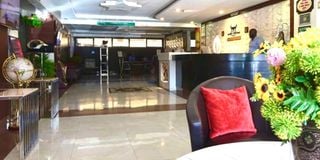At Ole Ken Hotel in Nakuru

The lobby of Ole Ken Hotel.
What you need to know:
- The hotel’s name is made up from the names of the two owners who have businesses in the town.
- In the lobby there is a huge photo-mural of a traditional Maasai ceremony.
I thought I knew Nakuru well. My first visit there was as long ago as 1968, when it still had the feel of a settler farmers’ town. I was co-facilitating a workshop on creative writing with Okot p’Bitek. One evening at a downtown nightclub, I learnt that Okot was not only one of Africa’s greatest poets and an international footballer, he was also an amazing dancer.
Remembering Okot, I can’t resist a diversion from my main theme… After the workshop, I drove back to Nairobi – a relaxed and less than two hours’ drive in those days – and I thought Okot was catching a bus to Kisumu. A couple of weeks later we met up at a staff meeting in Nairobi. (Okot was a colleague in the Institute of Adult Education at the University of Nairobi.) It was a rather boring meeting – until Okot passed me a manuscript.
It was a draft of his poem, Song of a Prisoner. Over a coffee after the meeting, he told me that before catching the Kisumu bus after the workshop, he had gone to a bar. He had a few drinks, got into an argument with someone, and that became a fight. He was arrested for causing a fracas, and he spent the night in gaol. ‘That’s when I wrote Song of the Prisoner,’ he said.
Before going back to the UK after my two years’ secondment at the university, I took a photograph of the countryside in the direction of Gilgil from the rim of Menengai Crater – a very open countryside. Returning to Kenya in 1986 – this time to stay – I took another photograph from the same place. Now, much of the land was covered with fertile shambas.
Nakuru town had grown, too, but it still had characteristics of its farming origins. Doing a two-day consultancy assignment last week, I soon got lost in the web of streets. With its shopping malls, restaurants and new hotels, Nakuru has well outgrown my memories of it. Bustling and boisterous, young city workers are outpacing the farmers.
Two good restaurants
If the Midland Hotel was built with the tastes of settler farmers in mind, I was staying at a hotel much more in keeping with the tastes of young city workers. It was the Ole Ken in West Road and only 200 metres from the busy Westside Mall.
I understand that the hotel’s name is made up from the names of the two owners who have businesses in the town – Oline Re-treads and Kenjap Motors. The aim was also to have a name with a Kenyan flavour. In the lobby there is a huge photo-mural of a traditional Maasai ceremony. Otherwise, the décor is nothing like the old style of tourist hotels such as the Norfolk or the Stanley. It is crisp black and white rather than brown and ochre; it is straight-lined rather than curved; it has plastic flowers rather than fresh ones. The prices are reasonably local rather than inflated expatriate.
The Ole Ken has two good restaurants, one serving Indian, Chinese and European cuisines; the other is an elegant vegetarian restaurant. The separate breakfast room has a plentiful buffet with a number of Kenyan dishes.
I was pleased with my fifth-floor room, with a view of the Menengai Crater and a strip of Lake Nakuru. My tip to the reception staff was to make sure new guests are escorted to their rooms, so they can be briefed about where things are and how things work. It was until the second day that I saw a switch for the water heater!
Otherwise, the receptionist, the manager and the waiters in the restaurant were all welcoming, attentive and informative. The next time I have business in Nakuru, I will be glad to see them all again.
John Fox is Chairman of iDC Email: [email protected]





